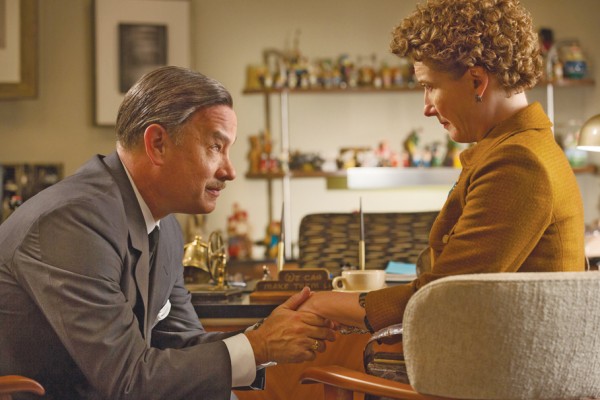
It’s 1961 and for the best part of two decades Walt Disney (Tom Hanks), following a pledge to his daughters, has attempted in vain to convince British-Australian author P.L. Travers (Emma Thompson) to part with the screen rights for her bestselling children’s novel Mary Poppins.
With bankruptcy looming, Travers reluctantly takes the advice of her agent and travels to Hollywood to consult with the mogul. There, she spends two tumultuous weeks collaborating with scriptwriter Don DaGradi (Bradley Whitford) and composer/lyricist brothers Richard (Jason Schwartzman) and Robert Sherman (B.J. Novak), making life as difficult for the trio and Walt as she possibly can.
During her time in Los Angeles (a city she describes as smelling of “chlorine and sweat”) Travers reminisces about her childhood in rural Australia. We see through flashbacks how she idolised her father (Colin Farrell), a romantic-natured alcoholic who drives his wife (Ruth Wilson) to attempt suicide.
The parallels between Travers’ childhood and the content of her famous novel are made clear, underlining her reluctance to part with the rights.
There are few figures in American popular culture as divisive as Walt Disney. Should we remember him as the movie mogul who brought joy to millions of cinemagoers through his work, or as the Nazi sympathiser who invited Leni Riefenstahl to America and attended meetings of the pro-Hitler German-American Bund?
Unsurprisingly, given the film is distributed by Disney, Saving Mister Banks opts for the former. It’s a celebration of nostalgia, almost a counter-argument to Woody Allen’s Midnight in Paris, which advised its audience to enjoy the present because those who lived in the rose-tinted past you romanticise about probably yearned themselves for an earlier era. Saving Mister Banks tells us it’s best to sugar-coat our memories and while it’s an argument you may not find thoroughly convincing, the film makes one hell of a pitch.
The direction of John Lee Hancock, a protégé of Clint Eastwood, is assured and confident but lightly handled, allowing his cast room to breathe but keeping the story visually interesting.
There are moments of cine-literate brilliance Spielberg would be proud of, best of all a shot that reverses the famous image of Richard Widmark’s arrival on the cattle buffer of a train in 1962’s How the West Was Won, the young Travers disappearing into the smoke filled distance on the back of a train bound for an uncertain future. Later, a simple blink-and-you’ll-miss-it glimpse of Travers’ painted toenails provides us with more insight to her troubled psyche than any wordy monologue might.
Thompson is outstanding in her role, as tough on the outside as she is brittle on the inside. Hanks seems born for the role of Uncle Walt and provides a calm counterpoint to his co-star’s more showy role. Paul Giamatti quietly steals his scenes as the put-upon chauffeur assigned to shuttle Travers around LA.
If Mary Poppins was set in an England that possibly never existed, the same could be said for Saving Mister Banks portrayal of sixties “Gee Whiz” Americana. The characters are all improbably good-natured, considering they work in the notoriously cut-throat world of Hollywood (though compared to today’s numbers-obsessed Hollywood, the movie industry of the sixties was positively altruistic).
If you can accept its schmaltz early on and allow yourself and the film to run with it, Saving Mister Banks is a movie as charming as the best of classic Disney.
Pictured: Tom Hanks and Emma Thompson in Saving Mister Banks.
Reviewed by Eric Hillis

